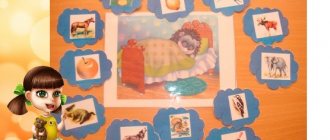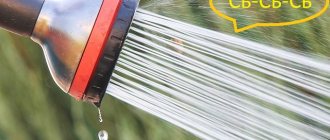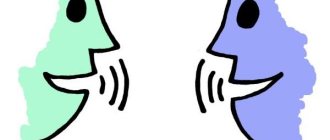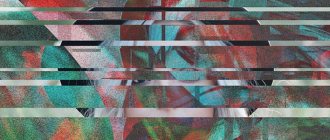Why is the production and automation of the sound Sh important?
You should not delay setting or correcting the “Sh” sound. Up to 3 years of age, children may still not be able to pronounce sounds clearly (within normal limits), but if this problem continues, then it is necessary to do articulatory gymnastics and teach the child to breathe correctly while pronouncing sounds.
The reason for the incorrect pronunciation may be: a short frenulum, adults “lisped” with the child in childhood (he heard his loved ones pronounce sounds, remembered this and adopted it).
If you give up on the production of “Ш”, the child will continue to replace the problematic sound with others, his speech (both oral and written) will not be understood by the teacher, as a result of which the student’s performance will decrease, and his peers will laugh at him. All this will lead to psychological trauma, complexes, and the child may withdraw into himself.
Voiced
When they are formed, the shape of the tongue is close to the form that produces voiceless sounds, but vibrations are added. Voiced consonant sounds create active vibrations of the ligaments. Vibrations deform the sound wave , and it is not the pure flow of air that enters the oral cavity, but the sound. Subsequently, it is further transformed by the tongue and lips.
Voiced consonants include: b, c, g, d, g, z, j, l, m, n, r.
When they are pronounced, tension is clearly felt in the larynx area. In addition, it is almost impossible to speak them clearly in a whisper.
A word in which all consonants are voiced: Rome, pride, ash, estuary.
Summary table of consonants (voiceless and voiced).
| Sound | [b'] | [b] | [V'] | [V] | [G'] | [G] | [d'] | [d] | [and] | [z'] | [h] | [th] | [l] | [m] | [n] | [R] |
| Ch. | [P'] | [P] | [f'] | [f] | [To'] | [To] | [T'] | [T] | [w] | [With'] | [With] | [X] | [ts] | [h] | [sch] |
Preparation of the articulatory apparatus
In order to start working on sound production, it is necessary to train the muscles of the oral cavity using speech gymnastics, which must be performed in front of a mirror.
Possible articulation exercises:
- “cup” or “bucket”: raise the tongue in a wide position to the upper teeth and hold for several seconds;
- “spatula”: place the tongue in the same position on the lower lip and hold for several seconds;
- stretch your lips forward in the form of a tube and smile (hold for 5 seconds);
- blow on soap bubbles, cotton balls, fluff, floating toys in the water;
- stretch out the tongue in the shape of a needle;
- make a “clock” with your tongue (move your tongue from side to side), “rocker” (the tongue is extended forward and you need to raise/lower its back);
- “whiten the mouth”: close the mouth, move the tongue across the palate, as if we were whitening it;
- "clatter";
- copy the movements of a cat's tongue when she laps milk.
Deaf
Quiet, it’s quite difficult to shout them. The vocal cords do not obstruct the movement of air from the lungs, and sound is formed by changing the shape of the lips and the position of the tongue.
Voiceless in Russian: [k], [p], [s], [t], [f], [x], [ts], [sh]. The easiest way to remember is a phrase, and not a set of letters, “Styopka, do you want a cheek? Fi!” containing them all.
An example in which all consonant sounds are unvoiced: rooster, honeycomb, pin.
This is interesting! How phonetic analysis of a word is done: an example of sound analysis
Technique of sound production Ш
You can make the sound “Ш” in different ways:
- imitating;
- with the help of articulatory gymnastics;
- using other sounds;
- mechanically.
At the initial stages, the child not only looks at the adult and repeats the correct pronunciation, but also looks at himself in the mirror and analyzes what he is doing wrong. The speech therapist or parent carefully watches how the baby pronounces the sound “SH” and makes correct comments.
Regular articulation gymnastics helps develop the speech apparatus, thanks to which the child pronounces sounds correctly.
When setting “Ш” you can use other sounds:
- just put the sound “Ш” from “T”. The baby repeats “T” continuously, rounds and moves his lips forward, smiles, directs air along the groove;
- when the child pronounces “R” correctly, it is necessary to “growl” in a whisper, gradually reduce the pressure of the exhaled air until there is no more vibration (a slight hiss appears);
- from the sound “S”, you need to whistle for a long time, slightly raise the edge of the tongue towards the upper incisors and release the air (the sound “SH” will be heard).
Mechanical devices (probe, spatula) help fix the desired position of the tongue, which are best used by a speech therapist, because not all parents have the skill to control them.
The speech therapist, using instruments, makes the sound “Ш” from the vowels “A”, “E”, “Y”, raising the child’s tongue to the upper palate, from the consonants “S”, “R”. When the “Sh” can be clearly heard, the instrument is removed and the baby “hisses” on his own.
II. Main part. 1. Comparative characteristics of the sounds S - Sh
1. Comparative characteristics of the sounds S - Sh.
S - consonant, deaf, hard, whistling, when pronounced, the lips are in a smile, the exhaled air is cold, the tip of the tongue rests on the lower teeth.
WITH‘ —
consonant, soft, voiceless, corresponds to green headphones, on the letter there is a green filled circle.
Ш - consonant, deaf, hard, hissing; when pronounced, the lips are drawn out into a tube, the exhaled air is warm, the tip of the tongue and the side edges are raised up, and the middle is lowered, i.e. the tongue takes the shape of a “cup”.
2. Correlating the sounds of the lesson with symbols and letters to indicate them in writing.
3. Differentiation of sounds among other sounds and among themselves.
Speech therapist:
Today we have an unusual lesson: Carlson, Malysh and Freken Bok will teach, and you will learn, Knowledge will always be useful to you!
The speech therapist puts on the board images of the heroes of the lesson: Carlson, Freken Bock and Baby.
Speech therapist: Listen to the sounds and raise the corresponding symbols when you hear the sounds of the activity.
Sounds: s, sh, z, zh, shch, u, c, zh, sh, s, f, s, sh.
Speech therapist: Look at the pictures (task 1, p. 16). Who needs these items? Write down the names of the heroes of the lesson. Highlight the letters S - Sh. Why did these particular heroes come to our lesson? (Their names contain the sounds S - Sh.)
Pictures: cake, puppy, candy, briefcase.
4. Differentiation of sounds S - Ш at the syllable level (task 2. p. 17).
Speech therapist: Baby and Carlson invite us to play with them. However, we will be able to play only when our friends complete the task that Freken Bock set for them. Help them: read the syllables without mistakes. Then Freken Bok will allow Baby and Carlson to play with us.
SA - SHA - SA SU - SHU - SHU
SO - SO - SHO YS - SY - YSH
5.Work on clarifying the dictionary (task 3. p. 17).
Speech therapist: Circle those items of clothing that are suitable for the Kid with a red circle, and those that suit Carlson with a green circle. Explain your choice.
Pictures: shorts, tie, shirt, socks, scarf, tracksuit.
6.Development of logical thinking.
Speech therapist: The kid chose what was needed. Now you can go outside.
Our friends are walking along the road - Cars, buses here and there. Friends need to be more careful, but how to cross the road?
Solve the crossword puzzle and the traffic light will turn green.
The speech therapist puts a crossword puzzle on the board.
1. The gardener waters flowers from it and fills the skating rink in winter. (Hose)
2.
“It gallops... through the fields, and the trough through the meadows,” wrote Korney Chukovsky.
(Sieve)
3. In winter, everything is white because everything is covered with it. (Snow)
4. The legs of the car are shod in... (Tires)
7.Development of spatial relationships (task 4, pp. 17-18).
Speech therapist: Carlson and the boy are standing in a store, and in front of them is a product on display. You name it where it is, pay the money and take it home. Help Baby and Carlson shop in the store: identify and write down the location of each item.
Images:
Speech therapist: What is in the upper right corner; in the lower left corner; between cherries and pencils; above the paper clips; in the lower right corner; in the upper left corner; to the left of the brush.
8. Physical exercise (task 5, p. 18).
Speech therapist: It’s time to hurry up your friends
But what should you buy for dinner? The products are as if invisible, it is difficult to recognize them in the picture.
Close your right eye, look at the superimposed images of objects and name them. Then close your left eye and do the same. Write down the names of the objects depicted. Select the letters S - W.
Pictures: pear, sausages, sausage, cherries, apricot.
The speech therapist hands out cards with overlaid images: cheese, sausages, sausage, pineapple, dried fruit, pear.
9. Differentiation C
-
S ' - Ш in words (task 6
, p. 18). Speech therapist:
The kid and Carlson came to the house,
They want to have dinner.
Check out the houses. Which house do you think the Kid lives in and which one Carlson lives in? Help Baby and Carlson collect their things: write down under each house the names of things with the corresponding sound S or Sh.
Pictures: bench, wardrobe, armchair, chair, table, couch.
///. Lesson summary
Speech therapist: The time for farewell has arrived, The bell is about to ring. They tell you goodbye: “Don’t be bored, goodbye!” Who will remember our lesson, And remember the words on time?
Children remember the topic of the lesson and choose words for Carlson and Malysh.
Automation of the sound Ш in syllables
After exercises to train the articulatory apparatus (with regular exercises), the sound pronunciation “Ш” is fixed in the syllables (repeated 3 times): -sha, -sho, -shu, -shi, -she, -ash, -osh, -ush, - ish, -esh, yosh, -yash, -yush.
The exercises are gradually complicated by other consonants:
| ShK PC SHV SHL | A |
| U | |
| ABOUT | |
| Y | |
| AND |
Unpaired consonants
The first group can be pronounced softly. The second has no analogues in pronunciation.
Unpaired consonants are divided into:
- sonors – [th'], [l], [l'], [m], [m'], [n], [n'], [r], [r']. When they are pronounced, a stream of air hits the upper sky, like a dome,
- hissing – [x], [x'], [ts], [h'], [h'].
The Russian alphabet contains letters that are difficult to understand in context. Are the sounds [ch], [th], [ts], [n] voiced or unvoiced? Learn these 4 letters!
Important! [h] - deaf! [th] - sonorous! [ts] is deaf! [n] – sonorous!
Unpaired consonants
Automation Ш at the beginning of a word
Following the adult, the child says: washer, gang, skank, jackal, shawl, scarf, chocolate, Scotsman, highway, hair, shorts, whisper, screen, chimpanzee, wide, fizzy, sewing, cipher, show, shopping, shock, shock, shaker, shocker, lisp, sheriff, six, sixteen, gear, patronage, sheffer, toss, moor, squall, locker, barrier, hat, spanking, shmotnik, smack, lace, spy, spinach, syringe, sprats, cheat sheet, putty, headquarters, staff, tripod, adit.
Automation Ш in sentences
To practice pure pronunciation, the child should repeat the sentences. This exercise is considered difficult.
- Alyosha and Natasha are walking happily.
- Misha wants to buy a big ball.
- Dasha hangs the scarf on a new hanger.
- Sasha rides a black horse.
- They are sewing a new fur coat for Mishutka.
- The fur coat has seams.
- Wear a gray fur coat and hat today.
- Yasha, wash your neck and ears.
- The car was fitted with new black tires.
- Natasha, give me a turret.
- Katyusha, put on your galoshes so your feet don’t get wet [w].
- Nastyusha used a sewing machine to sew 2 hats, 2 scarves and one fur coat for the doll.
- The baby has a pencil.
- The mouse rustles a piece of paper [w].
- The kid picked lilies of the valley.
- Our hut is very good.
- Katyusha sewed a shirt, but was in a hurry.
- Masha and Sasha followed Glasha.
- My books [w] are in the closet.
- There is a green frog sitting on the path [w].
- Pasha and I play chess.
- The cat runs after the mouse.
- Mishka got a bump on the top of his head.
- Our cat loves to play with a reel.
- I found different coils in my grandmother's box.
- Valyusha loves flatbreads and cheesecakes.
- A seamstress will sew a parachute for a toy on a machine.
Games for production and automation
If you conduct classes in the form of a game, the baby will not get tired and lose interest. An adult, using images, helps the child quickly understand how to pronounce the sound “Ш” correctly.
You can come up with a story: we pretend to be snakes or mice, and we need to quietly crawl to the food so that the cats don’t eat us.
When you need to practice the pronunciation of a sound, you can show pictures. The child looks at the image and names the objects. Afterwards, the task can be complicated: show a picture, and the child must describe what he sees, what actions and who is doing it.
Exercise “Finish the word”:
- SHA: Yes... (Dasha), ka... (porridge), Ma... (Masha), Mi... (Misha).
- SHU: pi... (writing), ma... (waving), but... (wearing), ko... (mow).
- SHI: we... (mice), small... (kids), halo... (galoshes), roofs... (roofs).
Exercise “There are many of us”:
- mouse - mice;
- baby - babies;
- hut - huts;
- reeds - reeds.
Exercise “Call me kindly”:
- Masha (Mashenka);
- Dasha (Dasha);
- Pasha (Pashenka);
- Misha (Mishenka);
- Sasha (Sasha).
Exercise “Continue the sentence” (sample “I write, and Misha writes):
- I wear, and... .
- I write and...
- I put it out, and... .
- I plow, and...
Exercise “Continue a series of words with the same root”:
- Noise (noisy, make noise).
- Jester (joke, joke).
- Step (step, walk).
Exercise “Put words into plural form” (sample “One baby - two kids - many kids”):
- reed;
- hut;
- galoshes;
- mouse;
- cat;
- mouse;
- midge.
Exercise “Putting words into the past form” (sample: Make noise – make noise – make noise):
- joke (joked - joked);
- hiss (hissed - made noise);
- rustle (rustled - rustled);
- whisper (whispered - whispered).
Exercise “Who does what?”:
- Reeds (makes noise).
- Mouse (rusts).
- Already (hisses).
- Naughty (being naughty).
Related posts:
- Rhoticism in speech - complete information Rhotacism (problem with the sound [P]) is the most common disorder in children...
- A child does not know how to say R - we’ll show you how to teach it. To teach a child to pronounce the letter R, you need to regularly perform special...
- The sound “Zh” - from production to automation Automation of the sound “Zh” begins with identifying the reasons that interfere with the correct sound pronunciation...
- What exercises are useful for rhinolalic patients? Corrective exercises for rhinolalia - articulation exercises, breathing and others...
Sibilant consonants and letters
Consonants whose pronunciation produces noise and hissing are called hissing. Such sounds make 4 consonant letters:
- zh - [zh];
- h - [h'];
- w - [w];
- sch - [sch'].
They cannot be pronounced with lips pressed tightly together. At the same time, the tip of the tongue rises to the sky, and space appears in the center. Air passes through it, creating a hissing sound.
The main features of consonant sounds are the formation of pairs:
- By softness / by hardness;
- By voicedness / by deafness.
Among the hissing ones stands out:
- The pair in terms of voicedness and deafness is [f] - [w] (wife - tire). The remaining hissing sounds [ch'] and [sch'] are unpaired unvoiced.
- The sizzling ones have no pairs of softness and hardness:
- [g] is always hard (even if there is a soft sign after it);
- [w] is always hard (even if there is a soft sign after it)
- [h'] always soft;
- [ш'] always soft.
The soft sign after hissing consonant letters does not soften them, but plays a grammatical role. (In the word “wilderness” it indicates the feminine gender. In “burn” - to the infinitive; in “read” - to the second person, singular; in “entirely” - to the fact that it is an adverb).
The soft sign is used in writing after sibilant consonants:
- at the end of feminine nouns, in the nominative case and singular: daughter, night, mouse, quiet.
- at the end of verbs (even reflexive ones): protect, guard, burn, beware).
- at the end of adverbs (after “zh” and “sh”): name, completely.
Not written at the end:
- nouns in the singular, in the masculine nominative case: reed, garage, cloak, beam.
- feminine or neuter nouns in the plural, in the genitive case (many groves).
- adjectives in short form: hot, fresh, volatile.
- adverbs that need to be remembered: really, unbearably, married.
There are difficulties in spelling vowels after sibilants:
- “O [o]” and “e [o]” under stress:
The letter "e" is written:
- being at the root of any part of speech (fur, cheap, walked, hard, chewed);
- in any part of the verb and in words formed from the verb (burns, bakes - in the ending; shade, demarcate - in suffixes; stew, conductor - in suffixes of nouns formed from the verb); permitted, armed - in participle suffixes; Baked, smoked - in the suffix “yon” of adjectives formed from verbs).
Exceptions: nouns - ozh(o)g, podzh(o)g, izzh(o)ga.
The letter "o" is written:
- in the endings of nouns (shoulder, drawing, cloak, ray);
- at the ending “he” of nouns in the plural and genitive case (knyazhon);
- in the suffixes of nouns “ok”, “onok”, “onk” (little river, berezhok, hook, old woman);
- in the suffixes of adjectives “ov”, “he” (hedgehog, reed, funny);
- in the suffix with adverbs “o” (hot, fresh, good). Exception: “yet”;
- in dictionary words: kryzh(o)vnik, zh(o)m, obzh(o)ra, trusch(o)ba, ratchet(o)tka, ch(o)porny, sh(o)v, ch(o) rolls, sh(o)roh;
- in words taken from the dialect: zh(o)kh, vech(o)r, ch(o)kh.
- in words with foreign language origin: mazh(o)r, kryush(o)n (exception - zh(e)st, plansh(e)t).
- “O [o]” and “e [o]” without accent:
The letter "e" is written:
- in the suffix “er” of nouns (boyfriend);
The letter "o" is written:
- in words of foreign origin: jockey, chocolate.
- "U", "a", "o":
- after hard sibilants (step, slang);
- in established rules: “cha” - “sha”; “chu” - “schu” (cup, thicket, sensitive, pike, glass, sorcerer);
- “I”, “e”, “e”:
- after soft sibilants (shield, clean);
- in the established rule: “zhi” - “shi”.
- "YU":
- in words with foreign origin: zh(yu)ri, parash(yu)t.
It is important to remember that first names, surnames, and abbreviations can be written with any vowel after a hissing consonant.





